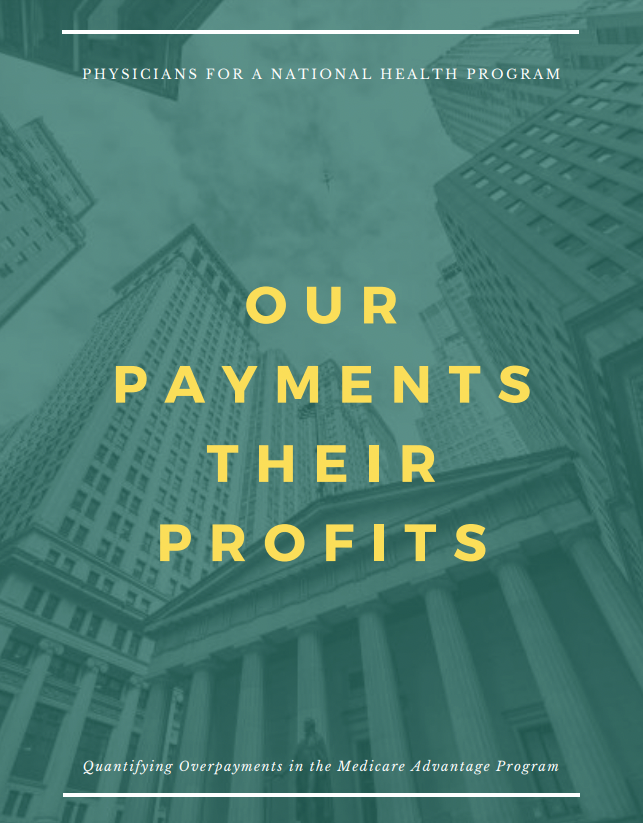News
Article
Physician group slams insurers for overcharging taxpayers for Medicare Advantage
Author(s):
Report: ‘Endless greed’ costs nation billions of dollars and health of patients.
Taxpayers are overpaying by at least $88 billion a year for Medicare Advantage, according to “Our Payments Their Profits: Quantifying Overpayments in the Medicare Advantage Program,” published this month by Physicians for a National Health Program.

Medicare Advantage has become a health care “cash cow” for insurance companies even as patient care suffers across the country, according to a new report.
Taxpayers are overpaying by at least $88 billion a year for Medicare Advantage (MA), also known as Medicare Part C, the privately administered health insurance program. Depending on the calculations, that overpayment may be as much $140 billion a year, according to “Our Payments Their Profits: Quantifying Overpayments in the Medicare Advantage Program,” published this month by Physicians for a National Health Program.
“Various elements of MA, either by design or by consequence, result in a much higher level of government spending than is necessary to provide Medicare benefits, with much of this money going toward corporate profits,” the report said. “Instead of creating a more efficient system of care, large corporations have used MA as their cash cow, taking billions in taxpayer dollars while using a plethora of tactics to delay or deny treatment for patients.”
Under MA, the federal government pays health insurance companies to manage patient care. Since 2007, MA enrollment has nearly tripled, with MA now managing more than half of all beneficiaries eligible for Medicare.
But the MA program is not saving money for taxpayers and there is no proof MA is leading to better outcomes for patients, the report said.
While patients are supposed to benefit from health insurance, health insurance companies actually benefit from:
Favorable selection: MA beneficiaries generally are healthier and thus have lower health care costs than beneficiaries in Traditional Medicare, as shown by multiple studies. There are various reasons for the difference in spending, the report said, but MA insurers are paid as though their beneficiaries have the same needs as Traditional Medicare beneficiaries, “when this is very clearly untrue.”
Overpayment for favorable selection is estimated at 11% to 14%, or $44 billion to $56 billion a year, according to PNHP.
Upcoding: When MA patients have more diagnoses, MA insurers receive more money, which creates an incentive to add conditions or inflate their severity. This problem may be the best known issue with MA, with Congress and the administration of President Joe Biden looking for solutions, the report said. In Traditional Medicare, physicians and providers are paid by fee for service, so there is no incentive for upcoding, the report said.
Upcoding led to $17 billion in excess payments to MA in 2021, the report said, citing findings by the federal Medicare Payment Advisory Commission. Based on 5% of total payments, overpayment is estimated about $20 billion for 2022, according to PNHP.
County benchmarks and quality bonuses: Created by the Affordable Care Act, benchmarks are set by Medicare to measure average levels of health care spending per Traditional Medicare per beneficiary, per county. Those are set higher than necessary to attract health insurance companies that “bid” for the chance to provide MA insurance, the report said. Meanwhile, the review process for rating MA plans and their bonuses is “highly flawed,” and together the bonuses and benchmarks total $24 billion to $28 billion, or 6% to 7%, in excess spending.
Induced utilization: The PNHP report described a study of “induced utilization,” or the likelihood of patients to seek out more care if health insurance covers more of the cost. This skews Medicare’s county benchmarks and “creates a situation where taxpayers are subsidizing supplemental coverage for MA, the report said. Based on the study findings, the 2022 overpayment to MA would be $36 billion, or approximately 9% of total spending, according to PNHP.
The PNHP report noted the estimates were preliminary because MA data “is shrouded in mystery,” unavailable to researchers or difficult to measure. It also does not account for MA insurer savings that come from delaying or denying patient care.
For comparison, a Congressional Budget Office report in 2019 estimated that adding dental, hearing and vision benefits to Medicare and Medicaid would cost $84 billion, according to PNHP.
“Even by our minimum estimate, private insurers receive more than enough surplus money to provide critically needed benefits to all Medicare and Medicaid beneficiaries,” the report said. “Medicare Advantage is just another example of the endless greed of the insurance industry poisoning American health care, siphoning money from vulnerable patients while delaying and denying necessary and often life-saving treatment.”





